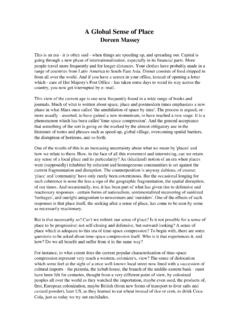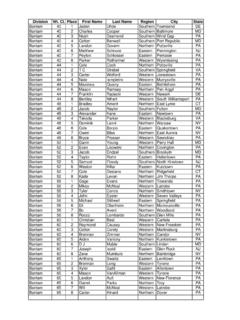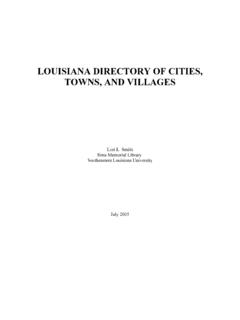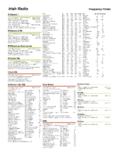Transcription of Parish Registers in the National Library of Ireland
1 Family History Research 2 Parish Registers in the National Library of Ireland For most family history researchers, Parish Registers provide the earliest DIRECT source of family information. Unlike earlier records, Parish Registers provide evidence of direct links between one generation and the next (via baptismal Registers ) and one family and another (via marriage Registers ). Because of their importance for family history research, in the 1950s and 1960s the National Library of Ireland carried out a programme of microfilming all of the Catholic Parish Registers available for microfilming at that time. As a result, the National Library holds microfilm copies of the Registers of most Catholic parishes in Ireland (including the counties of Northern Ireland ).
2 The start dates of the Registers vary from, for example, the 1740/50s in some city parishes in Dublin, Galway, Waterford, Cork and Limerick, to the 1780/90s in counties such as Kildare, Wexford, Waterford and Kilkenny. Many of the Parish Registers in counties on the western seaboard do not begin until the 1850/60s. The year 1880 was taken as the cut-off date for the microfilming of Parish Registers . By that date, civil or State registration was well under way and post-1880 genealogical information should be available from the General Register Office. The List of Parish Registers on Microfilm includes a list of parishes (by diocese), the covering dates of the Registers in each Parish , and the National Library Call Number ( ) of each film.
3 To establish the start-date of the Parish Registers relevant to your research, check the Library 's List of Parish Registers on Microfilm - also available online at If you are uncertain as to the diocese in which the Parish relevant to your research is situated, consult the Irish Catholic Directory which contains an alphabetical index to parishes at the back of each edition. Alternatively if you know the name of the civil Parish , you could consult either Samuel Lewis's Topographical Dictionary of Ireland (1837) which gives a description of each civil Parish and includes information regarding the corresponding Catholic Parish or the Civil to Catholic Parish list which lists civil parishes, the corresponding Catholic Parish and the relevant diocese.
4 Access to the Microfilms of the Registers : Microfilms of Registers for the following dioceses are available for consultation in the Library (names in brackets refer to counties or part of counties included in each diocese: Achonry (Mayo-Roscommon-Sligo), Ardagh and Clonmacnoise (Longford-Leitrim-Cavan-Roscommon- Sligo-Westmeath), Armagh (Derry-Tyrone-Armagh-Louth-Meath), Cashel and Emly (Tipperary- Limerick), Clogher (Fermanagh-Monaghan-Tyrone-Donegal-Louth -Cavan), Clonfert (Galway-Offaly- Roscommon), Cloyne (Cork), Cork & Ross (Cork City and Southern part of Co. Cork), Derry (Derry- Tyrone-Donegal), Down and Connor (Antrim- Down-Derry), Dromore (Antrim-Armagh-Down), Dublin (Dublin-Wicklow-Carlow-Kildare-Laois-Wex ford), Elphin (Roscommon-Sligo-Westmeath), Ferns (Wexford-Wicklow), Galway (Galway-Mayo-Clare), Kerry ( Kerry-Cork), Kildare and Leighlin (Kildare-Offaly-Laois-Kilkenny-Carlow-Wi cklow-Wexford), Limerick (Limerick), Killala (Mayo-Sligo), Killaloe (Clare- Laois-Limerick-Offaly-Tipperary), Kilmore (Cavan-Leitrim-Fermanagh-Meath-Sligo), Meath (Meath-Westmeath-Offaly-Longford-Louth-D ublin-Cavan), Ossory (Kilkenny-Laois-Offaly), Raphoe (Donegal), Tuam (Mayo-Galway-Roscommon))
5 , Waterford and Lismore (Waterford-Tipperary- Cork). What kind of information is contained in the Registers ? The quality of the information in the Registers may vary from Parish to Parish . In general, however, baptismal Registers contain the following information: Date of baptism Child's name Father's name Mother's name and maiden name Names of godparents (Place of residence is often included). Marriage Registers contain the names of the bride and groom and their witnesses. In some cases place of residence is also recorded. The Registers are handwritten and include records of baptisms and marriages, but only rarely include records of deaths.
6 Latin is used in many Registers , but neither surnames nor placenames were translated into Latin. The same firstnames are used over and over again so you will become very familiar with the Latin forms used. Research in the Registers : Having obtained the relevant microfilm, begin your research by scanning the first page or two of the register simply to become familiar with the kind of format or pattern used by the priest when recording baptisms and marriages. You are looking, first, for a SURNAME or SURNAMES and then for the particular information given in relevant entries. As you search through the records, remember (and this applies to all genealogical research): - Take into account all surname variants.
7 Until recently, there was no real standardisation in the spelling of many surnames. If you have an O prefix to your name it was probably not used by most record-takers (or by your ancestors) in the 19th century. - If you are uncertain as to which particular entries refer to your family then you must note all possibilities. As your information begins to build up from other sources you can eliminate those entries that prove to be irrelevant. - Always note your sources. Note where you discovered a particular baptism or marriage. - Note the exact years and records searched, even those records in which you found nothing. You don't want to have to search the same record twice.
8 THE National Library DOES NOT PROVIDE COPIES OF, OR TRANSCRIPTIONS FROM, Registers . ORIGINAL AND POST-1880 Registers ARE GENERALLY IN THE CUSTODY OF. THE LOCAL Parish PRIEST. (The address can be obtained from the Irish Catholic Directory). Research Centres around the country have now indexed many Parish Registers . These indexes are available to search online for a fee at







